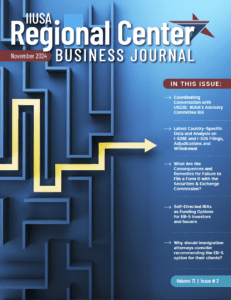
This is a member perspective and the views of the author are their own and do not necessarily reflect the views or position of IIUSA.
IUSA is grateful to its members for their insights, expertise, and willingness to help guide the EB5 discussion. The association always encourages involvement in the dialogue and process to improve the EB5 ecosystem but does not always endorse all aspects or language of reprinted articles.
By Mona Shah, Managing Partner, Mona Shah and Associates Global and Rebecca Singh, Partner, Mona Shah and Associates Global
As EB-5 practitioners furiously collect themselves following this week’s proposal from U.S. Citizenship and Immigration Services (“USCIS”) to raise its filing fees, the industry has found itself questioning the mercurial agency’s motivation … and not liking the probable answers.
USCIS is proposing an astronomical increase in the filing fees required for EB-5 visa applications. The fees were hardly modest to begin with, but they are an absolute bargain compared to the newly suggested charges. Per USCIS, the proposed fee increases are meant to compensate for the agency’s lack of resources – resources that would allow them to “provide adequate service to applicants and petitioners or be able to keep pace with incoming benefit request workload.”
Translation: We’re cash-poor and understaffed, so we need more money from you to prevent us from not doing our job in a timely and efficient manner.
Below is a chart of current vs. newly proposed filing fees for the relevant forms:

The percentage jumps are astonishing. The proposed new fee for I-526/I-526E forms is $11,160, a whopping 204% jump from the current $3,675 fee. Meanwhile, the I-829 fee would rise 154% from $3,750 to $9,525; both fees are required to be paid by the individual investors. The I-956 and I-956F would increase 168% from $17,795 to $47,695, and the I-956G would surge a comparatively minuscule 47% from $3,035 to $4,470.
Unanswered Questions:
Some questions it behooves USCIS to answer include but are certainly not limited to:
- Will these new EB-5 form fees be incorporated into RCs’ reauthorization plans by the end of 2023?
- How did USCIS arrive at these numbers?
- What precisely, will the windfall of fees be used for? Which Department of Homeland Security (“DHS”) department will benefit? Will the money be put into a pool and used for all and sundry, or will it be used for the benefit of EB-5 investors and projects?
- Will an RC wishing to recertify or make a simple amendment to structure or geography be compelled to pay the new, exorbitant I-956 fee?
Is it even practical to assume that an increase in fee-based funding would mean a more functional USCIS? The fees were last adjusted and increased all the way back in 2016, and the problems facing USCIS certainly predate that adjustment. An increase in funding does not necessarily mean that it is guaranteed more staff or more resources. Furthermore, as it is unlikely that many will be willing to hand over this much money, one must wonder if USCIS would even see a marked increase in income or if this is just a (perhaps desperate) attempt to collect whatever it can.








